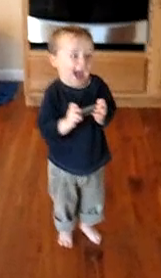Below is my final Expressive Typography project. The project included two parts: a printed book along with a motion video. Overall, I learned a lot about typography and what the choice of type, position of type, etc. can say to a reader and how this can communicate my message as a designer.
The speech I chose to work with was an excerpt from Nelson Mandela's Inaugural Address.
At the beginning of the book part of the project, I really tried to find meaning in all of the words and portray this through the type. Some of the ideas were cheesy and some of the ideas were effective. Through this exploration, I have narrowed down my final ideas into the spreads you see in my final type book. During this process I had to learn a balance of effective expressive type, and how to balance this with clean type. I originally chose to work with the color blue because it was the color that stood for freedom on South Africa's flag, and this directly correlates with Mandela's speech. The color reads well to the viewer as freedom, and overall gives the book an inviting tone. The pop of yellow works well with the blue for contrast with the blue to really display the type choices I'm making when I use the yellow. I also decided to include pictures from Nelson Mandela when he was giving this speech, as well as photos from when people were protesting him being in jail, and relevant photos from South Africa that documented the ideas Mandela is talking about in the speech. I think these photos throughout the book help tell the story to the reader along with the type, without distracting from the words. After designing the book, I started designing the motion video.
At first when designing the video, I decided to design it separate from the book in the fact that I didn't want the video to look like my spreads in motion. I made all the type expressive on its own (while using most of the same principles from my book) and then added the photos and colors after, to give that connection to the book. I was very intimidated by after effects at first, because I had never used it before, but now feel very accomplished and am excited to keep expanding upon my knowledge of after effects. With the video I was able to portray some of my expressive type ideas from the book even better when given the opportunity for motion. Like the word "wounds" that cuts as he says it. Its the same cut in the book, but is so much stronger to the reader when they see that motion happening as he is saying it. I think matching music with the speech is also a big part of the video being effective, and I like how the music I found builds as he is talking and has an inspiring feel to it, as he is talking about how freedom has come for his people. Because I was able to design actual motion with the video, I thought more about how these words could become more powerful for the viewer in the video. Overall, I learned a completely new design program as well as how timing, sound, movement, and type can effect a viewers learning and seeing experience. I really enjoyed this project and feel like I learned a lot about typography and what it can say to the world.




























